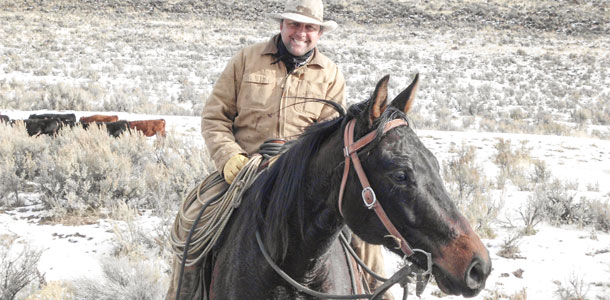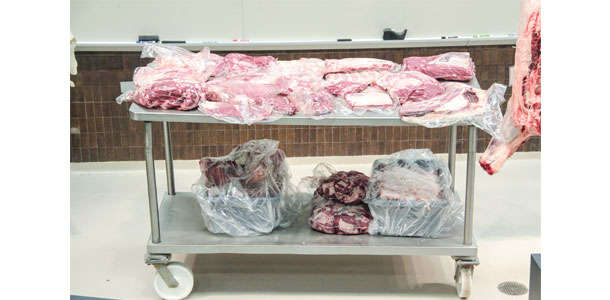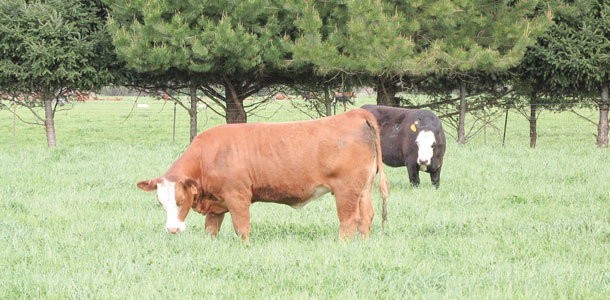Stacy Davies from Roaring Springs Ranch in Oregon and Country Natural Beef, says niche markets provide ranchers an opportunity to tell the good story about beef and connect with consumers.
These markets put a face on the people producing food, and consumers know where and how their beef products are being raised.
In mainstream markets the producer has no contact with consumers; the consumer has no idea where the beef originated or how it was fed. Niche markets personalize the food-producing process.
 “There are several reasons to do it,” says Davies. “One is the extra money, but another is the opportunity to tell the story of ranching and connect with consumers. The requirements involved to sell beef through a niche market are not that challenging. Most of us already do the main things required.”
“There are several reasons to do it,” says Davies. “One is the extra money, but another is the opportunity to tell the story of ranching and connect with consumers. The requirements involved to sell beef through a niche market are not that challenging. Most of us already do the main things required.”
Many ranchers could easily shift to a niche market because they already feel that the criteria involved are the best way to handle cattle and take care of the land. It’s just one more step to become certified.
“Often the certification doesn’t require additional work but might require additional record-keeping,” explains Davies.
“The benefit is that it strengthens the industry. In these markets, we feel we have converted a lot of vegetarians back to beef-eating. The reasons they became vegetarians were often misunderstandings.
“By having the certification to alleviate their concern, whether it be animal welfare, environmental or production-practice concern, ranchers are able to connect and show certification, and these vegetarians became beef-eaters again. We have expanded beef sales nationwide and worldwide with niche market products.”
He believes that small retail chains and small mom-and-pop restaurants, to be able to compete with the big stores, need products different enough to bring people in. “The niche beef products are widely used to attract people to that smaller store or restaurant,” says Davies.
Consumers go out of their way to patronize these stores and restaurants because they know the beef is good and raised the way they want to see it raised.
“The health and longevity of our beef industry depends on all our markets, with many outlets. If we have to depend on Walmart to buy all our beef, we are in trouble,” he says.
Marketing challenges
Some small producers try to do the whole process themselves – raising/finishing the animals and selling the meat directly to customers. Dr. Rick Machen, Texas A&M AgriLife Extension service animal and natural resource management specialist, has worked with small to mid-size grass-fed producers and hosts the annual TAMU Grass-fed Beef Conference.
“The most sustainable system for grass-fed beef in our part of the world is harvesting fleshy 700- to 750-pound calves (baby beef) at weaning,” he says. These animals are growing fast, fat from mother’s milk and good forage, and the meat is tender.
“The challenge in our region is having enough quality forage at the right time to grow and finish cattle on forage. Most years, long hot summers take a toll on the quality of our warm-season perennial forages."
"Periods of forage dormancy often result in cattle being 24 to 28 months old before they finally get to a finished harvest weight and level of fatness,” Machen says.
“Some grass-fed operations have portions of three calf crops on the farm at the same time. As age at harvest increases, so does the total forage required and cost of production. Moving from traditional cow-calf (calves sold at weaning) to grass finishing requires significant reduction in cow inventory to allow forage for the growing/finishing operation.”
Most commercial cattlemen sell calves at weaning. “This is the lowest-risk, least-involved marketing approach. Contrast that with selling beef direct to a consumer, and all the tasks performed by people in the middle – stocker operators, feed yards, packing plants, wholesalers, retailers, etc."
"People who decide to direct market their own beef often underestimate the time required and the additional pieces of that puzzle,” he says.
 “Finding a harvest facility/processor who will harvest cattle and process/package on the producers’ schedule and according to their specs can be a significant challenge. Inventory management becomes another management challenge."
“Finding a harvest facility/processor who will harvest cattle and process/package on the producers’ schedule and according to their specs can be a significant challenge. Inventory management becomes another management challenge."
"Unless niche marketers can sell whole carcasses, halves or quarters direct from processor to consumer, frozen storage in which to warehouse product will be needed,” says Machen.
Getting started
Kathy Panner, Riddle, Oregon, raises grass-fed beef. “I read Joel Salatin’s advice when we first started. He told people to make sure they had a quality product to sell. Grow some, eat some yourself, give some to neighbors and see if they come back and want more,” she says.

“My second piece of advice is to study the articles in Stockman GrassFarmer, by Dr. Anibal Pordomingo from Argentina, to understand what it takes to put a good grass-fed product on the market on a consistent basis. It is not just pulling big yearlings off pasture, harvesting them and calling them grass-fed. Do your homework and make sure you have the capability of producing a good product.”
One entry option for producers into a niche market is cooperating with an already existing branded product, such as an established grass-fed or natural market.
“I encourage them to investigate opportunities to participate as a cooperating grower/producer,” says Machen. “They can see how that goes, and how long it takes to produce those animals to those specs, and how their forage shapes up for this program.
“I recommend doing that with a portion of the calf crop, selling most of the calves through their traditional market. This can keep the cow-calf enterprise going while they test the waters of niche marketing,” he says.
“This can be a way to get your feet wet, learn from mistakes on a small scale, gradually working into a successful forage-finishing program. We have several ‘cooperator’ ventures here in Texas, one of which harvests 700- to 800-pound calves at weaning, and this program is run by a producer who has 50 cows."
"They market all their calves through the program as well as 100 more annually from cooperating growers. Cooperating growers are paid a premium over what those calves are worth as feeder cattle at weaning,” says Machen.
“This program is eight years old and has experienced steady growth. One of the greatest challenges has been finding a packer who will harvest and package those cattle to their exact specifications."
"Most of our small local packing plants are busy and harvest schedules are crowded. If you have to haul calves much further than their routine marketplace, this can jeopardize profitability.” You have to consider the cost of getting them there and the potential stress on the animals if they must be hauled a long distance for harvest.
“Most of the companies that sell niche products have people in place to help producers get past the roadblocks,” says Davies.
“Whatever the challenge might be, there is someone who could help them figure it out. Here at Country Natural Beef, our people are willing to talk to people if they have any questions about natural or animal welfare or environmental criteria, even if they are not selling to us."
"If a producer is not a fit for Country Natural Beef and wants to be grass-fed or lives in a different part of the country, we’ll connect that producer with a company in their area that’s a fit for them. The niche companies have a big network; we help each other. The end goal is for consumers to have an enjoyable eating experience and want to come back for more,” he says. ![]()
Heather Thomas is a freelance writer based in Idaho.
To read more about the challenge of forage finishing click here.
To read more about understanding cuts of meat click here.
PHOTOS
PHOTO 1: Cattle on the Roaring Springs Ranch are marketed through Country Natural Beef. Photo courtesy of Roaring Springs Ranch.
PHOTO 2: Stacy Davies manages Roaring Springs Ranch in Oregon and is involved with Country National Beef. Photo courtesy of Roaring Springs Ranch.
PHOTO 3: The end products after a demonstration cutting up a side of beef at the annual Grass-fed Beef Conference at Texas A&M University. Photo courtesy of Rich Machen.
PHOTO 4: Yearling steers finishing on grass in Kathy Panner’s grass-fed beef program. Photo courtesy of Kathy Panner.








